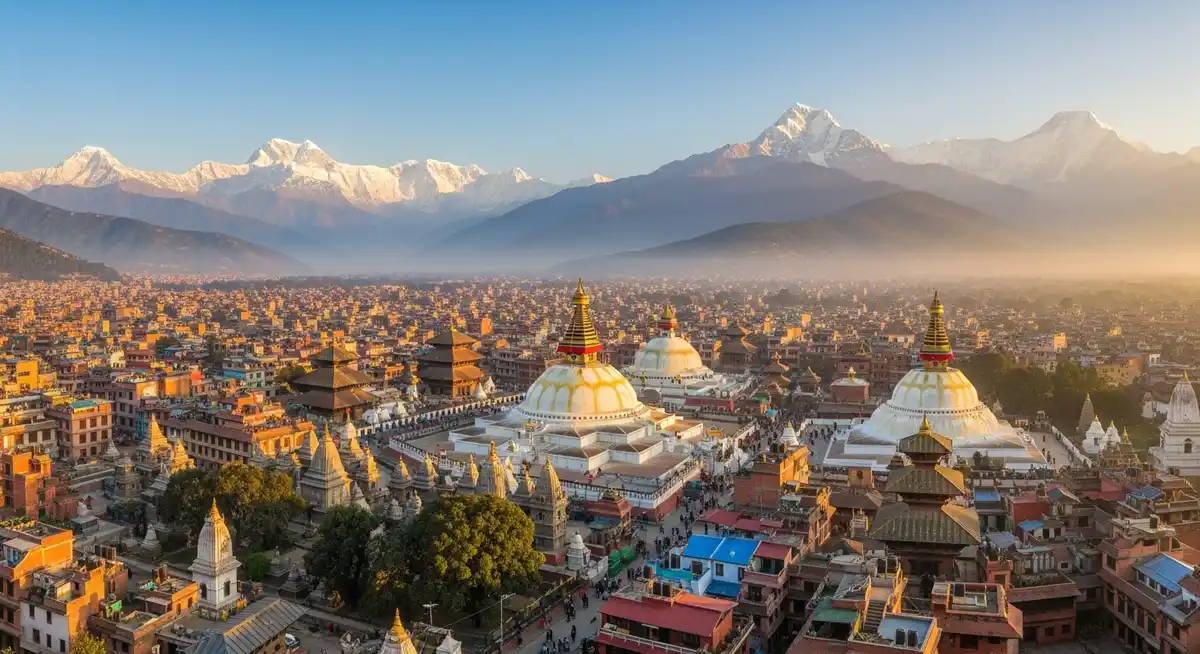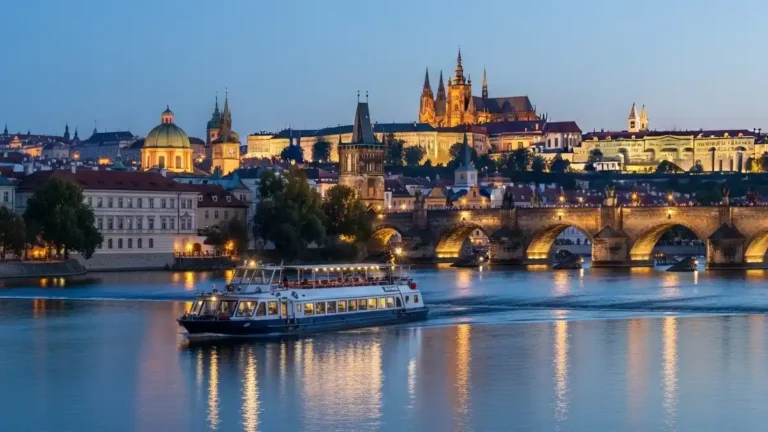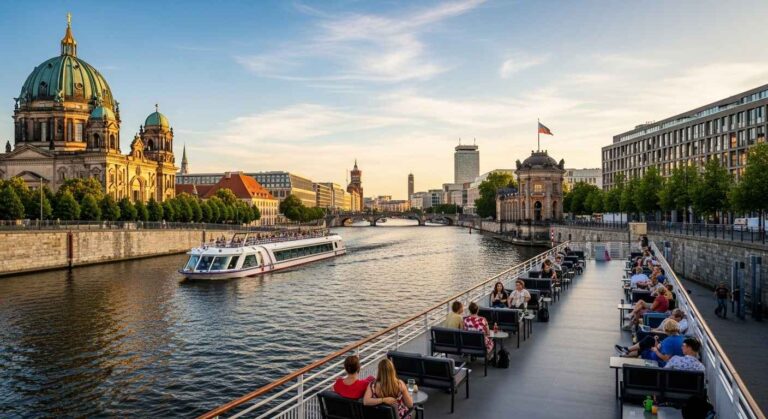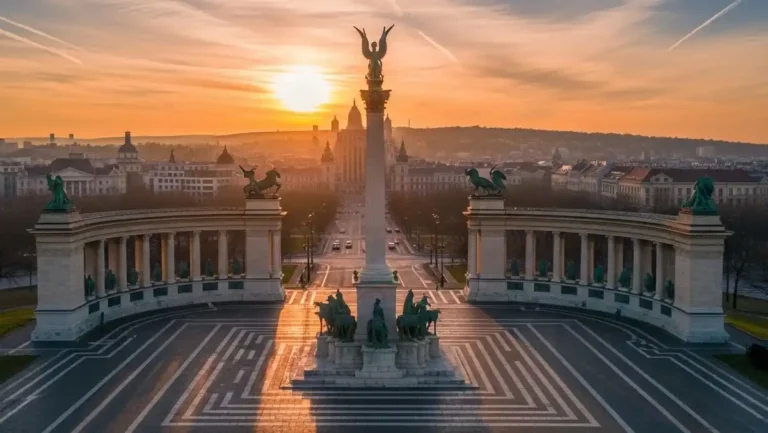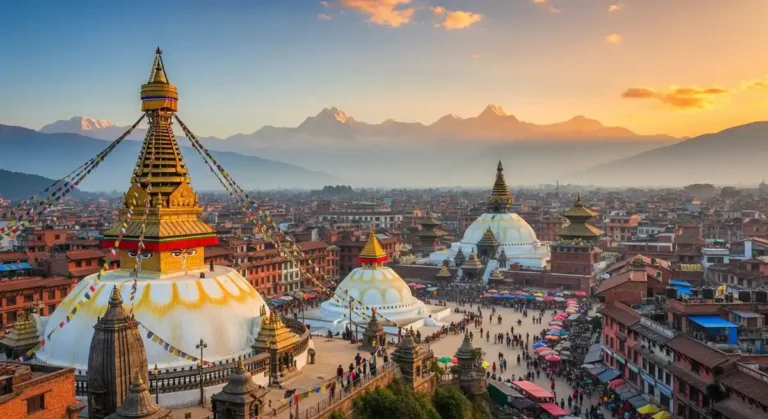25 Best Things to Do in Kathmandu for First-Time Travelers
Kathmandu isn’t just a city—it’s a living museum of culture, colors, and mountain air. From ancient temples to buzzing bazaars, every corner tells a story that pulls you in deeper. Whether you seek history, food, or adventure, the capital of Nepal is where discovery never ends.
Kathmandu, the capital of Nepal, is a place where your senses come alive. The city is full of alleyways, lively traffic, buzzing motorbikes, ringing horns, and smiling pedestrians.
The scent of street food from local vendors, the sound of temple bells, and the color of busy shops and restaurants create an aroma of excitement. In Potter’s Square, you can watch locals making bricks and crockery, while the smell of incense fills the air. It is both fascinating and full of life.
The city offers a mix of ancient and modern charm. Visitors can explore Hindu temples like Pashupatinath with its gold-topped roof, or admire Buddhist stupas that reflect deep spiritual roots.
- Vibrant City Experience – Kathmandu is alive with bustling streets, street food aromas, temple bells, colorful bazaars, and warm “Namaste” greetings. It blends ancient traditions with modern charm.
- Cultural & Historical Heritage – Home to UNESCO World Heritage Sites such as Kathmandu Durbar Square, Swayambhunath (Monkey Temple), Pashupatinath Temple, Boudhanath Stupa, Patan, Bhaktapur, and Changu Narayan Temple.
- Art, Museums & Markets – Highlights include Patan Museum, Narayanhiti Palace Museum, MONA, and local markets like Asan Bazaar, Indra Chowk, and Thamel, offering handicrafts, spices, jewelry, and trekking gear.
- Festivals & Best Seasons – Autumn (Sept–Nov) and Spring (Mar–May) are ideal for clear views and festivals (Dashain, Tihar, Holi, Buddha Jayanti). Winter is cooler but cultural, and summer offers greenery and monsoon festivals.
- Outdoor Adventures – Popular trips include hikes in Shivapuri & Nagarjun National Parks, sunrise views in Nagarkot & Dhulikhel, rafting in Sun Kosi, bungee jumping at Bhote Kosi, and helicopter tours to Everest Base Camp.
- Food & Nightlife – Must-try foods include momo, dal bhat, Newari cuisine (chatamari, yomari, samay baji), and street snacks (sel roti, jhol momo). Thamel is the hub for restaurants, live music bars, and nightlife.
- Travel Logistics – Access via Tribhuvan International Airport; local transport includes ride-hailing apps, buses, rickshaws, and tourist buses. Walking is best in Thamel and historic areas.
- Day Trips & Excursions – Easy cultural and scenic escapes include Bhaktapur, Patan, Namo Buddha, Chandragiri Hill, and Nagarkot for Himalayan views.
- Shopping & Local Crafts – Pashmina, Thangka paintings, Khukuri knives, Lokta paper, and fair-trade handicrafts from artisan groups (ACP, Mahaguthi, Local Women’s Handicrafts) promote ethical shopping.
- Suggested Itineraries –
- 24 hours: Durbar Square → Swayambhunath → Pashupatinath → Boudhanath → Thamel dinner.
- 2–3 days: Day 1 – Kathmandu + Swayambhunath; Day 2 – Patan + Pashupatinath + Boudhanath; Day 3 – Bhaktapur or Nagarkot.
The UNESCO-listed royal complexes, including the Durbar Squares, highlight the culture of the Newaris, historic inhabitants of the Kathmandu Valley. Alongside this, the bazaars such as Asan Tole, contemporary art spaces like the RN Joshi Museum of Modern Art, and the diverse cuisines make the city truly captivating.
The streets may be dusty, but they are alive with signs, colorful shops, and unique souvenirs. Every turn offers something new, from lively Walking paths filled with cars, cheerful dogs barking, or locals greeting you with a warm Namaste and a smile.
Tasting food, exploring historical sites, or taking photos in front of snow-capped mountains and hidden valleys make the visit unforgettable.
Kathmandu also stands at an elevation of 1,400 metres in the Himalayan foothills, between China and India. It serves as the gateway to the Nepalese Himalayan mountains, including famous treks like Everest, Manaslu, and the Annapurna circuit trek.
With an urban population of over 1.5 million, it remains the center of history, art, culture, and economy, enriched by its multiethnic blend of Hindu and Buddhist traditions.
Travelers can find both energy and peace in the bustling metropolis. In Thamel, a favorite tourist hub, there are cozy restaurants, bakeries, and cafes. The backstreets, bazaars, courtyards, and royal palaces with the Himalayan mountain range in the backdrop bring an unmatched magic.
With its endless discoveries, from tours to trekking in Pokhara or reaching Everest Basecamp, the city is a true mecca for mountaineers, humanitarians, trekkers, and adventure travellers. Every visit feels worth the time, leaving you with memorable experiences and favourite places to return to.
Planning Your Trip to Kathmandu
Best time to visit
Kathmandu offers unique charms in every season. Here’s how the year looks for travelers:
- Autumn (September–November): Best for clear mountain views, pleasant weather, and festivals like Dashain, Tihar, and Indra Jatra.
- Spring (March–May): Warm temperatures, blossoming flowers, and colorful celebrations such as Holi, Bisket Jatra, and Buddha Jayanti.
- Winter (December–February): Cooler days but still bright, perfect for exploring temples, wildlife in Chitwan, and enjoying Losar celebrations.
- Summer (June–August): A lush green valley with cultural highlights like Teej and Gai Jatra, plus dry escapes to regions like Upper Mustang.
Every season in Kathmandu has its own beauty, making it easy to enjoy festivals, sightseeing, and natural landscapes throughout the year.
How to get to Kathmandu
The capital of Nepal is best reached through Tribhuvan International Airport (KTM). Major airlines connect from the Middle East, Asia, and global hubs in Europe, America, Australasia, and South Africa. Both direct and connecting flights are available.
For travelers nearby, overland routes from India, Pakistan, and Tibet are also possible. Whether by bus, car, bike tour, or train from Dehli, these journeys offer scenic views and cultural connections.
On arrival, the airport is welcoming. Keep your passport, papers, and a pen handy for easy processing. The mix of adventure and zen will greet you right away, setting the mood for your trip.
Getting around to Kathmandu
Exploring Kathmandu Valley is simple with many transport choices:
- Ride-hailing apps (Pathao, InDrive): Easy and quick to book taxis.
- Sajha buses: Comfortable government-run green buses for main routes.
- Rickshaws: Fun for short sightseeing rides in historic areas.
- Walking: Best in Thamel and nearby tourist spots.
- Tourist buses: Comfortable for inter-city trips to Pokhara or Chitwan.
- Domestic flights: Fast travel to destinations like Lukla.
- Rental cars with drivers: Efficient for exploring winding roads and longer routes.
Travelers should also keep a face mask handy for pollution and enjoy the city’s lively atmosphere while staying comfortable.
Top Cultural & Historical Attractions in Kathmandu
1. Kathmandu Durbar Square
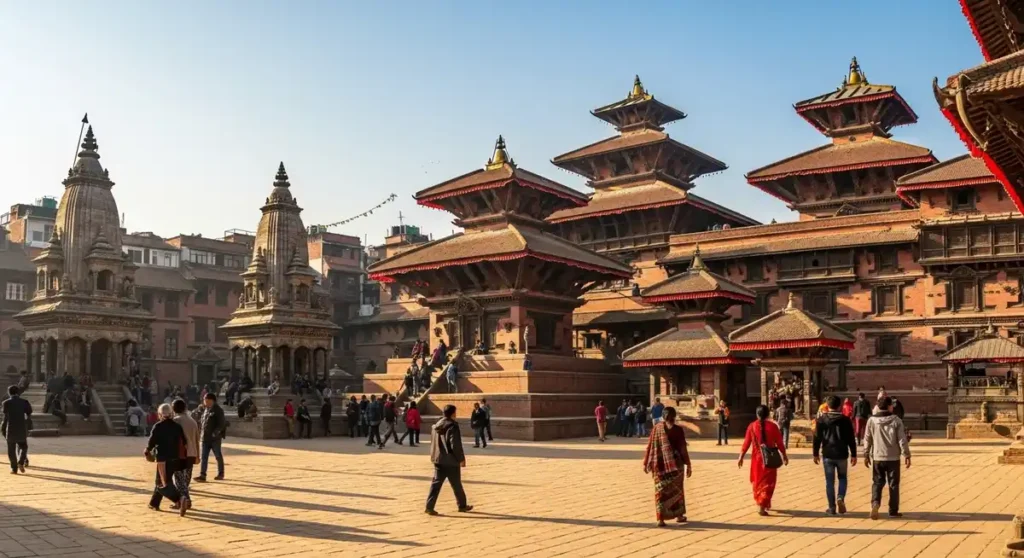
Kathmandu Durbar Square stands as one of the most historically and culturally significant sites in Nepal. Once the royal palace square of the Malla kings and later the Shah Dynasty, it reflects the cultural prosperity of the nation.
This largest palace square in the south of the city center is a living space filled with ancient buildings, palace complexes, and splendid sculptures, making it a world-famous tourist attraction.
Walking through the outer complex, visitors find 16th-century temples from the reign of the Malla monarchs. These buildings are adorned with meticulously carved facades, highlighting the beauty of Newar architecture.
At the central palace, the Nautalle Durbar, a nine-story tower built by Prithvi Narayan Shah to commemorate the Unification of Nepal, rises high. On the southern edge, the Kumari Chouk or Kumari Bahal houses the resident Kumari, a young girl worshiped as the living embodiment of the Hindu Goddess Durga.
Known also as Basantapur Durbar and Hanuman Dhoka, or Basantapur Durbar Kshetra and हनुमानढोका दरबार in Nepali, and येँ लायकु 𑐥𑐾𑑄 𑐮𑐵𑐫𑐎𑐹 in Nepal Bhasa, the site reflects layers of history.
The Licchavi kings of the 4th to 8th centuries AD began the construction, later expanded by King Pratap Malla in the 17th century. Today, its intricate wood carvings and rich heritage continue to inspire visitors from around the world.
The square is often called the Museum of Temples because it contains more than 50 temples, including the Taleju Bhawani Temple, Kasthamandap, Shiva-Parvati Temple, and Kumari Ghar.
Around Gaddi Baithak, handicraft shops offer attractive purchasable handicrafts, adding charm to the courtyards. The inner section of the main palace now houses museums dedicated to three generations of Shah kings, welcoming tourists every week to explore its premises.
This lively and bustling space remains not just an architectural treasure but also a home to the religious and ethnic characteristics of the Nepalese dynasties. Each successive monarch built ideal palaces and temples here, leaving behind a remarkable legacy that continues to shine in the heart of Kathmandu.
2. Swayambhunath Stupa (Monkey Temple)
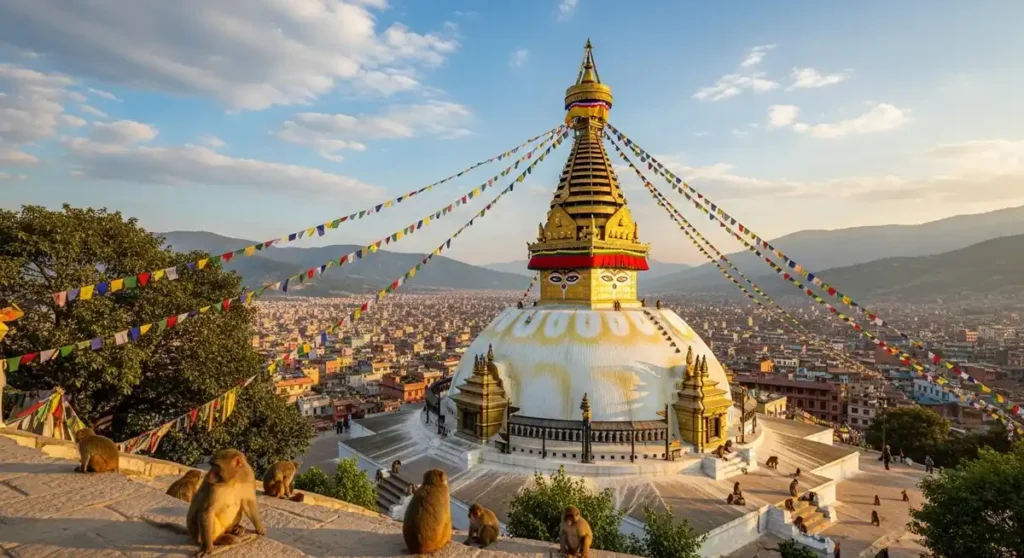
High on a hilltop west of Kathmandu, the Swayambhu stupa stands as one of the oldest and most sacred sites in Nepal. Surrounded by shrines, monasteries, and Chaityas, it draws both Buddhists and Hindus who come here for prayers, offerings, and worship. The gentle walk around the prayer wheels, moving clockwise, creates a deep sense of faith and harmony.
The stupa carries a rich legend. It is believed to have appeared from a lotus flower rising out of a primordial lake, where the Adi-Buddha revealed himself. Later, Manadeva built the first structure in 460 A.D., and by the 13th century it had become a center of Newar Buddhism and Vajrayana traditions.
The site honors many Buddhas, including Koṇāgamana Buddha, Kakusandha Buddha, Kassapa Buddha, Gautama Buddha, and Sakyamuni Buddha.
Visitors are welcomed by the shining gold plated Vajra, often called a thunderbolt or lightning bolt, at the stupa’s entrance. Above it rises the spire, decorated with layers of gold and sacred designs. The restoration in 2010 renewed its glory, and today the monuments, statues, and offering places still reflect its universal and outstanding value as a UNESCO World Heritage Site since 1979.
The site is also known by its nickname, the Monkey Temple, for the playful wandering monkeys that live on the hillock. According to a story, they came into being through Manjusri, a great deity.
Around the hill are temples dedicated to the Goddess Saraswati and Harati, once an ogress who became the loving caretaker of children. This blend of Hindu temples, deities, iconography, Tibetan paintings, and cultural unison makes the site truly special.
Beyond the spiritual experience, shops, restaurants, and small stalls offer souvenirs, Tibetan food, and warm hospitality. Whether joining the devotees, exploring the monasteries, or simply enjoying the panoramic view of the valley, the Swayambhunath Stupa is one of the most popular and sacred Buddhist pilgrimage destinations in the world.
3. Pashupatinath Temple
The Pashupatinath Temple in the Kathmandu Valley is one of the holiest sites in South Asia. Known in Nepali as श्री पशुपतिनाथ मन्दिर, it is surrounded by sacred ashrams, inscriptions, and ancient images. The temple covers many hectares, with more than 500 mini-temples, and is famous for its golden pagoda-style architecture.
Linked in stories from the Skanda Purana, Shiva Purana, and the Mahabharata, the linga of Shiva here is believed to grant wishes. The temple also shares spiritual ties with Kashi Vishwanath Temple in India and the Himalayan temples of Kedarnath, Rudranath, Kalpeshwar, Madhyamaheshwar, and Tungnath. The priests, known as Vedic Dravida Brahmins from Karnataka, are trained at the Sringeri Sharada Peetham in Southern India.
During major festivals like Shivaratri—the Night of Lord Shiva—thousands of devotees, pilgrims, sadhus, and ascetics gather for darshan of the sacred lingam.
On Teej in September, Hindu women in red sarees with yellow and green bead necklaces pray for their families’ well-being, prosperity, and longevity. Special Ekadashi days such as Harishayani Ekadashi in Ashadh and Haribodhini Ekadashi in Kartik also draw many pilgrims.
The temple grounds include the Slesh Mantak forest, home to monkeys and deer, and the evening Pashupati Bagmati Aarati is a highlight for visitors and devotees. With its history dating back to the 5th century BCE and its current stone and metal structure from the 15th century CE, Pashupatinath Temple stands as a timeless place of worship, culture, and living tradition in Nepal.
4. Boudhanath Stupa
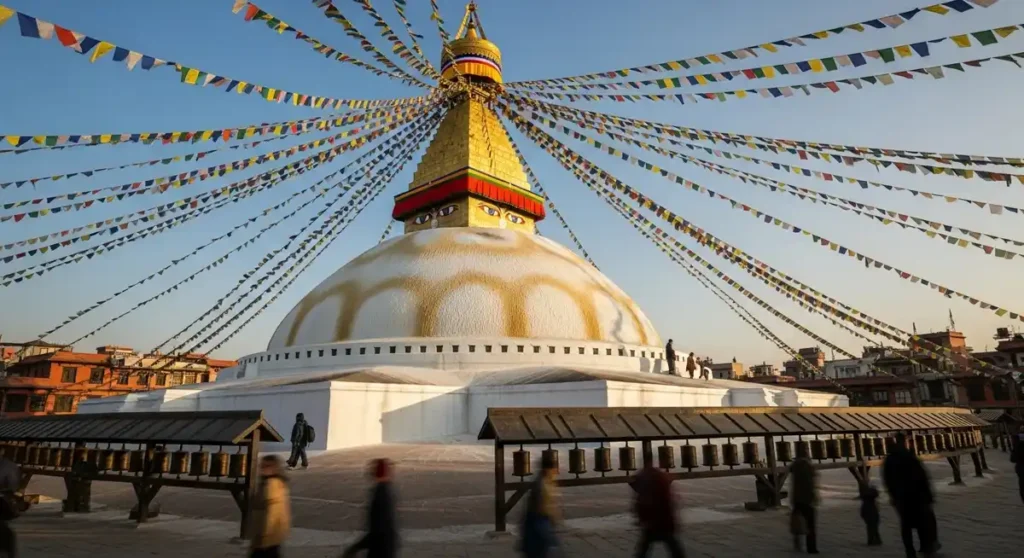
The Boudha Stupa, also called बौद्धनाथ, खास्ति चैत्य, Jarung Kashor, and in Standard Tibetan བྱ་རུང་ཁ་ཤོར།, stands as a timeless spiritual icon in Kathmandu Valley. Its beauty is more than its size; it is the enlightened mind of the Buddhas expressed in stone and design. Surrounded once by rice paddies, this stupa gave roots to Tibetan Buddhism and became a symbol of peace.
Inside, the stupa holds consecrated substances and sacred Body relics, including pieces linked to Kassapa Buddha and Shakyamuni Buddha. Along with Dharmakaya relics, Dharma relics, Cloth relics, and representations of Body, Speech, Mind, Mind Qualities, and Activity, it carries layers of faith. Its vast mandala makes it one of the largest spherical stupas on earth, honored in 1979 as part of UNESCO World Heritage Sites.
Travelers once crossed the old trade route from Tibet through Sankhu, passing the Charumati Stupa in Chabahil, and onward to Bagmati River, Lalitpur, and the Malla Kingdom in Patan. For centuries, Tibetan merchants rested here, offering prayers before moving on.
Nearby, the Statue of Padmasambhava at Ghyoilisang peace park and the turning of Prayer wheels with the mantra of Avalokiteshvara, Om mani padme hum, keep the atmosphere alive with devotion.
The stupa also became home to the Tibetan refugees after the 1959 Tibetan uprising, forming a strong diaspora around it. They built gompas, Buddhist monasteries, and created a living circle of restaurants, guesthouses, and artisanal businesses. Alongside Swayambhunath and Namo Buddha, it is a vibrant pilgrimage site for Buddhists and a magnet for tourists seeking its sacred aura.
At the northern entrance, one finds the shrine of the Dharma protectress Mammo Pukkasi, also revered as Hariti or Ajima by Newari Buddhists. Her Ganachakra offerings are kept by the Mahaguru Gompa, connecting daily worship to the past.
With its whitewashed dome, gilded tower, and all-seeing eyes, the stupa shines as both an architectural wonder and a sacred path to enlightenment. The design tells the journey: plinth as earth, kumbha as water, harmika as fire, spire as air, and the umbrella as void or ether, leading to nirvana.
Around its base are 108 images of Dhyani Buddha Amitabha, a number cherished in Tibetan culture, along with circles of prayer wheels set in niches.
Here, the Eyes of Buddha gaze with wisdom, compassion, and timeless presence. Whether walking koras, standing in the courtyard, or joining other devotees, one feels the power of Boudhanath Stupa as a living symbol of peace, faith, and unity.
5. Chabahil & Smaller Hidden Stupas
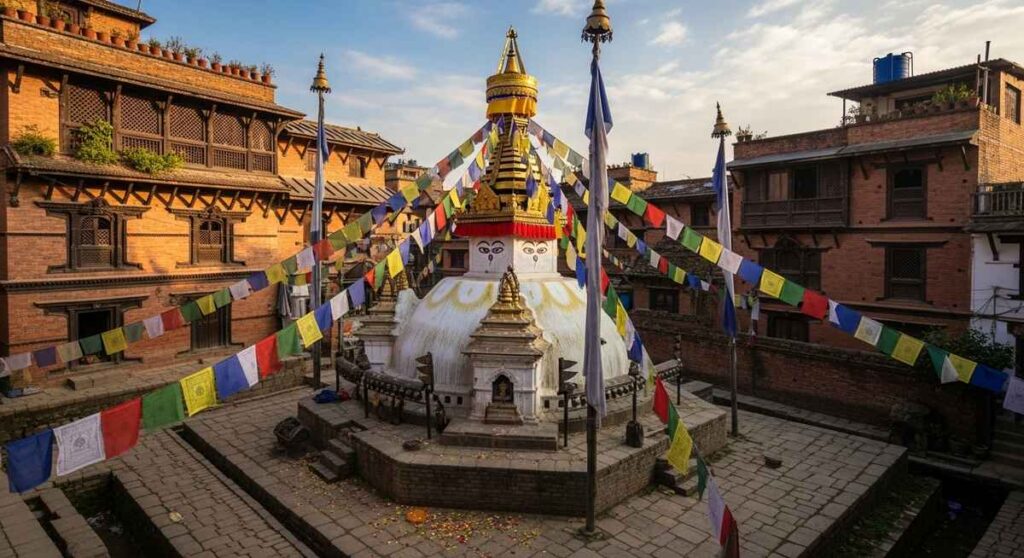
Chabahil & Smaller Hidden Stupas are ancient Buddhist sites in Kathmandu, Nepal, linked to Charumati, the daughter of emperor Ashoka. The Charumati Stupa, also called the Chabahil Stupa or Dhan Dhoj Stupa, dates back to the 4th century and holds great religious and historical value. It is close to Boudha Stupa, Pashupatinath, and Guhyeswari, making Chabahil a sacred and culturally rich area.
Walking through Chabahil, an ancient neighborhood in northeast Kathmandu, you come across the Charumati Stupa. Known also as the Chabahil Stupa or Dhan Dhoj Stupa, it stands close to the Boudha Stupa inside Kathmandu Metropolitan City Ward 07.
Built in the 4th century by Charumati, the daughter of the Indian emperor Ashoka, this sacred stupa carries a timeless story. Many historians consider the Licchavi stupa, called the Dhando Chaitya, as the oldest Buddhist Stupa in the valley.
Over centuries, the site has been carefully restored. In 2003, a restoration process revealed ancient artefacts, coins, and manuscripts from the Licchavi era. Again in 2015, after the April 2015 Nepal earthquake, it was renewed to preserve its beauty.
The imposing stupa is today known as the fourth largest in the Kathmandu area, after Bodhnath, Swayambhunath, and the Kathesimbhu Stupa near Thahiti Chowk.
Chabahil is now a thriving residential and commercial area, yet it has kept its spiritual charm. The nearby temples of Pashupatinath and Guhyeswari, dedicated to Lord Shiva and his consort Sati, are more than a thousand years old. In everyday Nepali life, with the script चाबहिल still seen on walls, Chabahil continues to honor its ancient legend, deep roots, and Buddhist heritage.
Museums, Art & Architecture
6. Patan Museum – A Palace of Art and Culture
The Patan Museum inside Patan Durbar Square is one of the finest cultural sites. Once home to the Malla Kings, it now houses statues, religious art, and symbolic designs. Its courtyard, terrace, and restored palace walls present Hindu and Buddhist heritage that is part of the UNESCO sites of the Valley.
7. Narayanhiti Palace Museum – Royal Grandeur
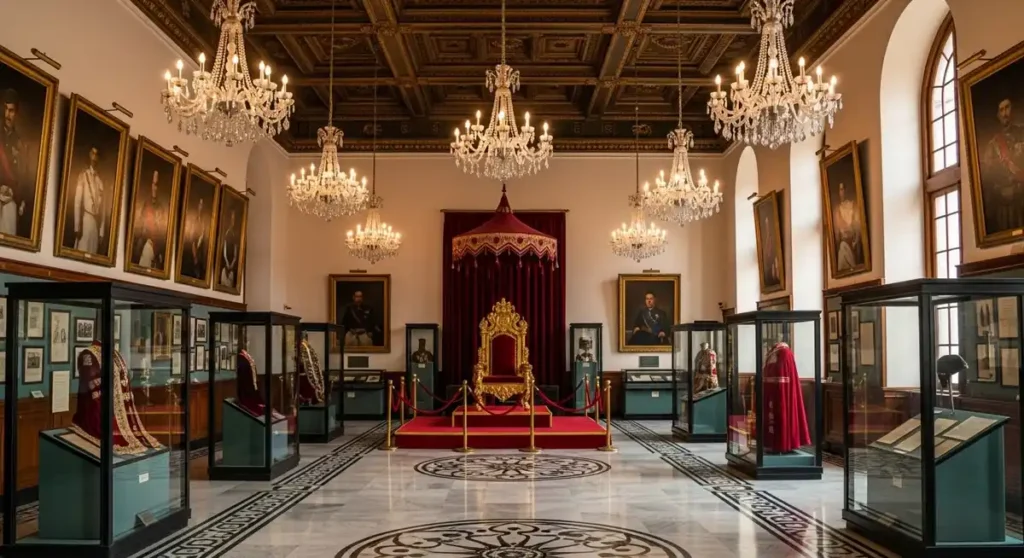
The Narayanhiti Palace Museum shows the lifestyle of Nepal’s monarchy. Built in the 1960s, its grand halls, marble floor, and crown displays bring the history of the royal family alive. Tickets range from 500 rupees ($5 USD) to Rs. 500 (SAARC), making it accessible to all.
8. National Museum of Nepal – History in Chhauni
Located in Chhauni, the National Museum of Nepal presents rich collections across three wings: the Historical Building, a Buddhist Art Gallery, and the main museum. Visitors see bronze statues, stone carving, idols, dolls collection, and sections on anthropology, archaeology, and natural history.
9. Taragaon Museum – Modern Meets Traditional
The Taragaon Museum, designed by Austrian architect Pruscha in the 1970s, blends modernist design with Nepali architecture. Once a hostel for artists, it became a museum building in 2014. Visitors enjoy photographs, sculpture, and the open courtyard.
10. Museum of Nepali Art (MONA) – Contemporary Exhibits
In lively Thamel, MONA offers rotating exhibits of contemporary art and Nepali Art. Located in the Kathmandu Guest House, it is well curated and inspired by international styles from Italy and Germany. The ticket price is Rs. 700, making it an attractive stop for art lovers.
11. Music Museum of Nepal – Folk Traditions
In Tripureshwor, the Music Museum of Nepal focuses on Nepali Folk traditions. Its collection includes Nepali instruments like the sarangi and Madal, alongside photographs from the 1980s and 1990s. Nearby, the University offers music classes, making it a lively cultural area.
12. Itumbaha Museum & City Museum Kathmandu – Local Stories
The Itumbaha Museum, inside a historic monastery, highlights religion and anthropology, while the City Museum Kathmandu adds modern insights into urban history. Together, they offer both ancient and contemporary perspectives.
13. Art Galleries – Vibrant Creative Spaces
Kathmandu’s art scene thrives in galleries like Siddhartha Art Gallery, Nepal Art Council Gallery, Kathmandu Art House, and Boudha Art Gallery. These spaces display fine exhibits, folk art, and works from unknown artists, adding energy to the Valley’s cultural heritage.
Markets, Shopping & Local Life
14. Asan Bazaar & Indra Chowk (local spices, fabrics, daily life)
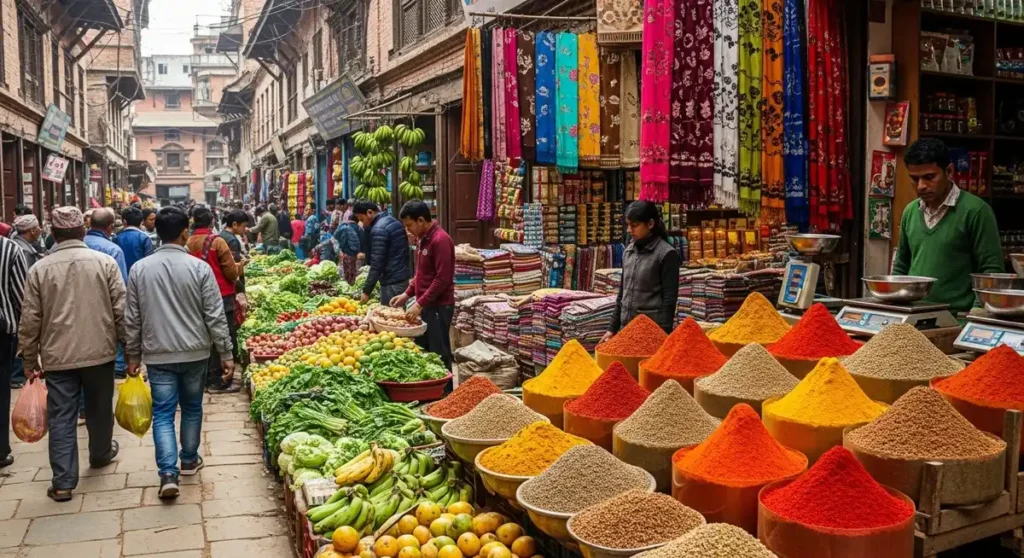
Asan Bazaar & Indra Chowk are two of the most vibrant markets in Kathmandu. They are famous for fresh spices, colorful textiles, handcrafted jewelry, and lively daily life scenes, where visitors can enjoy local snacks, explore temples, and experience the rich culture of the Nepali people.
Walking through Asan Bazaar is a culinary adventure. The market is full of fresh produce, bright spices, and tasty street food like crispy samosas, hot momo dumplings, sweet jalebis, soft sel roti doughnuts, and thin chatamari crepes.
The aromas fill the streets, and the atmosphere is joyful with chatter and laughter. Shoppers can also find textiles, kitchenware, and unique crafts that reflect local tradition.
Just nearby, Indra Chowk shines with handcrafted jewelry, silver designs, and colorful fabrics. The stalls here are a treasure for shopping, and bargaining with friendly vendors adds to the fun. Walking the alleyways of Old Asan and Asan Tole, visitors see historic temples, sacred shrines, and the grand Seto Machhendranath with detailed carvings.
Guided by experts like Ghale Treks on a Local Bazaar Walking Tour, this exploration becomes a true cultural experience, blending history, heritage, and modern life in the lively city of Kathmandu.
15. Thamel District (souvenirs, handicrafts, trekking gear)
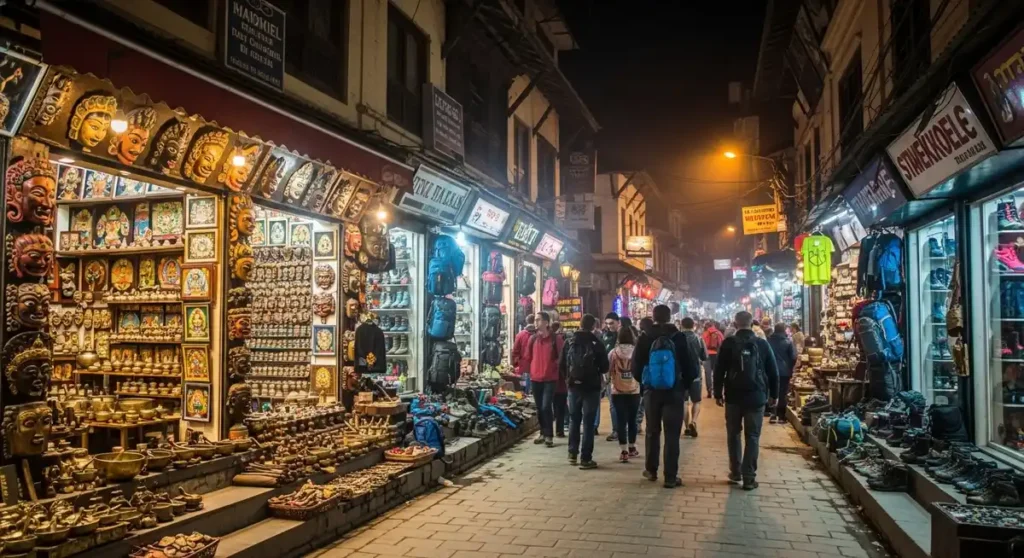
Walking through the lively Thamel District in Kathmandu feels like stepping into a world of colors and culture. The streets are full of shopping choices where souvenirs and handicrafts are everywhere. Soft pashmina shawls made from the hair of the mountain goat shine in every stall.
The sound of singing bowls made of metal and stone fills the air, often used for meditation and healing practices. Beautiful Thangkas with scroll paintings show Tibetan Buddhist deities and mandalas, while Nepali art carries traditional forms and elaborate designs.
The charm of Thamel also lies in its crafts. Sharp Khukuris, the famous curved Gurkha knives, are displayed with unique designs. Handmade Lokta paper scrolls, books, and craft items sit beside fine jewelry decorated with beads and local stones. You will also find metal and stone statues, religious figures, and detailed sculptures that reflect local artistry.
For outdoor enthusiasts, the area offers plenty of trekking and hiking gear, along with mountaineering equipment and specialized items, making it a perfect stop before heading to the mountains.
16. Pilgrims Book House & Specialty Stores
Pilgrims Book House is more than a publishing and bookselling company. Founded in 1984 in Kathmandu, Nepal, it grew under Puspa and Rama Nand Tiwari. The store expanded from its roots in Varanasi, India, later opening a branch in Delhi.
Starting with the Book Faith India imprint, it now publishes under the Pilgrims Publishing imprint. Their websites also feature a rare department, showcasing unique works for readers around the world.
The store is known for being one of the largest bookshops in Asia, praised by Lonely Planet and many guidebooks. With its Extensive Book Collection, readers can enjoy works on the Himalayas, Mountaineering, Tibet, India, Central Asia, and Nepal.
It offers Reprints of classic titles and books in multiple languages such as Nepali, Tibetan, and Hindi. Themes like Buddhism, Hinduism, yoga, and philosophy make it a rich place for knowledge seekers, along with lively Children’s books.
Beyond books, the store serves as a Cultural Hub. Inside, visitors find souvenirs, handicrafts, pashminas, textiles, maps, soaps, and incense. With specialty items and traditional crafts, it feels like a cultural supermarket.
There are also antique pieces, clothing, and even a music store, creating a vibrant space for Multi Section Shopping. Its Convenient Location in Thamel makes it a central landmark for locals and tourists alike.
What makes it stand out are its Key Features. This Multi Story Store covers three floors filled with vast inventory. Visitors can explore arts, handmade crafts, and unique Cultural Merchandise.
Specialty Items such as herbal cosmetics, aroma oils, and authentic products enhance the shopping experience. Every visit here offers a Unique Experience, blending the warmth of a bookstore with the richness of cultural souvenirs and heritage.
17. Ethical shopping & supporting local artisans
Ethical shopping in Kathmandu means choosing fair-trade shops, community markets, and online platforms that support local artisans. Visitors can find handmade handicrafts, textiles, ceramics, Thangka paintings, herbal products, and more from groups like Mahaguthi, Local Women’s Handicrafts, and the Association of Craft Producers (ACP). These places promote sustainable practices and help empower Women and Nepali artisans.
Walking through the streets of Kathmandu, I always enjoy exploring markets in Patan and Bhaktapur. The community spaces are full of authentic items such as scarves, ceramics, and paintings. Many artisans work ethically and use sustainable practices, making each piece feel special and meaningful.
At Mahaguthi and Local Women’s Handicrafts in Paknajol, I saw how handmade products are created with care. These organizations not only sell fair-trade items but also focus on empowering Women and creating long-term incomes.
The Association of Craft Producers (ACP), a non-profit founded in 1984, continues to provide fair income to low-income Nepali artisans, including those in remote villages.
I also enjoy exploring ethical Boutiques like Yala Mandala and The Local Project, which collaborate directly with craftsmen. In Bhaktapur, I once watched traditional wood carvings, pottery, and metalwork being made. Seeing craftsmen at work in an ancient city is a memorable way to connect with authentic souvenirs and specialties.
For those who prefer online options, Avendi Local is a trusted platform that offers a curated selection of handmade Nepalese gifts. The delivery within Kathmandu makes it easy to support local makers while shopping mindfully.
When it comes to what to buy, I always look for Pashmina, Dhaka scarves, textiles, and clothing accessories. Other popular picks include herbal wellness products, Buddhist statues, and Cultural art such as Thangka paintings.
Many shops also have beaded handcrafted ceramics, pottery, wood carvings, and metalwork. These unique, traditional, and sustainable crafts make every purchase a way to support local artisans while bringing home something meaningful.
18. Outdoor Adventures in and Around Kathmandu
Outdoor adventures near Kathmandu bring both peace and thrill. You can enjoy exploring the Shivapuri and Nagarjun National Park, which is full of nature, fresh air, and even some wildlife. It’s an excellent choice for hiking and a refreshing day trip close to the city.
For breathtaking views, head to Nagarkot or Dhulikhel. These places are known for their scenic landscapes and panoramic sights of the Himalayas. The natural beauty of the mountains at sunrise makes these spots a favorite destination for travelers seeking calm and wonder.
If you like adventure sports, you’ll find many exciting choices. The Sun Kosi is famous for white water rafting with fast rivers that make every ride fun. At the Bhote Kosi River, you can try bungee jumping, a thrilling activity at a famous location that gives a rush of pure joy.
For something truly special, take a helicopter tour to Everest Base Camp. The aerial views of the Himalayas are simply spectacular and offer an incredible way to see the mountains. Without the need for a long trek, these tours provide an unforgettable experience of the world’s highest peaks.
Food & Nightlife in Kathmandu
19. Must-Try Nepali Foods (momo, dal bhat, Newari cuisine)
When you travel to Nepal, food is part of the adventure. Walking through the streets of Kathmandu or lively Thamel, you’ll find restaurants serving both local dishes and western food. From Nepali restaurant gems like Yangling, Thakali Kitchen, and Silauta Restaurant, to cozy spots like Cafe Mitra and Rickshaw Cafe and Bar, there’s always something tasty waiting for you.
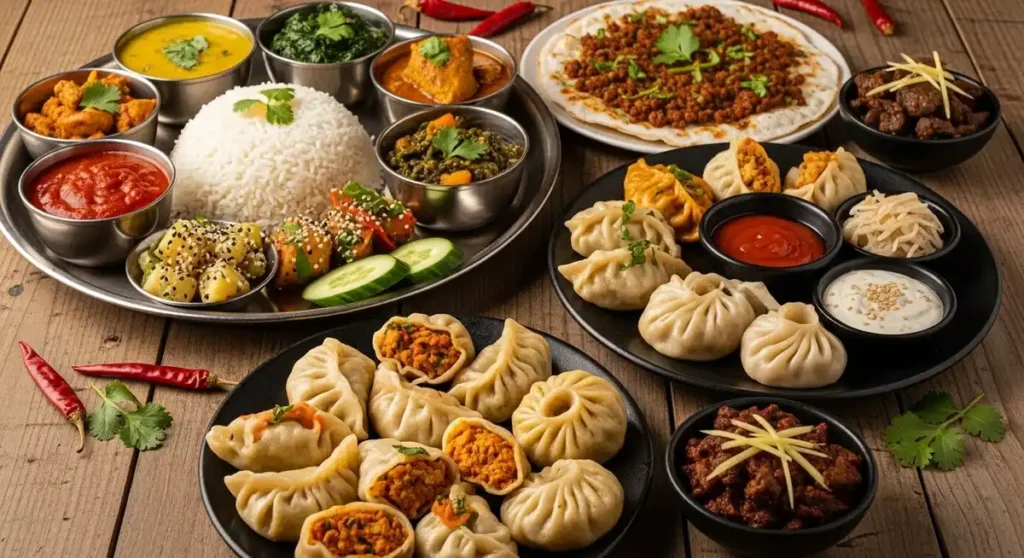
Here are some delicious foods you should not miss:
- Momo – The most loved Nepali street food. These soft dumplings come with vegetables, chicken, or buffalo fillings. Try Kothe Momo with a special sauce, or even vegan momo for a lighter option.
- Dal Bhat Tarkari – A complete meal of dal (lentil soup), steamed rice, and tarkari (vegetable curry). Often served with aaloo saag (spinach) or extra sides, this staple keeps you full and happy.
- Newari cuisine – A rich food tradition from the Kathmandu Valley.
- Chatamari – A rice flour crepe known as “Nepali pizza,” topped with egg, meat, and cooked vegetables.
- Yomari – A festival sweet dumpling filled with molasses, made from rice flour.
- Samay Baji – A Newari platter with puffed rice, boiled eggs, chhoyela (grilled meat), and aaloo saag.
- Sekuwa – Marinated and skewered meat (often chicken or buffalo) grilled to perfection.
- Thukpa – A Tibetan soup, warm and nourishing, often with noodles and broth.
- Gundruk – Fermented leafy greens served as a soup or side.
- Sel Roti – A ring-shaped rice bread or donut, crispy and festive.
- Aloo Tama – A flavorful curry of potato and bamboo shoots.
- Kwati – A healthy soup made from nine types of sprouted beans and lentils.
Beyond these, Nepal also offers thali sets, vegan dal bhat, sweet lassi, and even international food like Italian, Mexican, French, and American dishes. Whether in a street-side stall or at La Dolce Vita Italian, Roadhouse Cafe, or OR2K, the mix of affordable prices, fresh food, and authentic cuisine makes eating in Nepal unforgettable.
20. Street food culture in Kathmandu
Street Food Culture in Kathmandu is full of rich flavors, vibrant aromas, and diverse traditions. From momos and chatamari to sel roti and jhol momo, the streets of the city offer a lively mix of tastes that connect people, celebrate festivals, and showcase Nepal’s creativity.
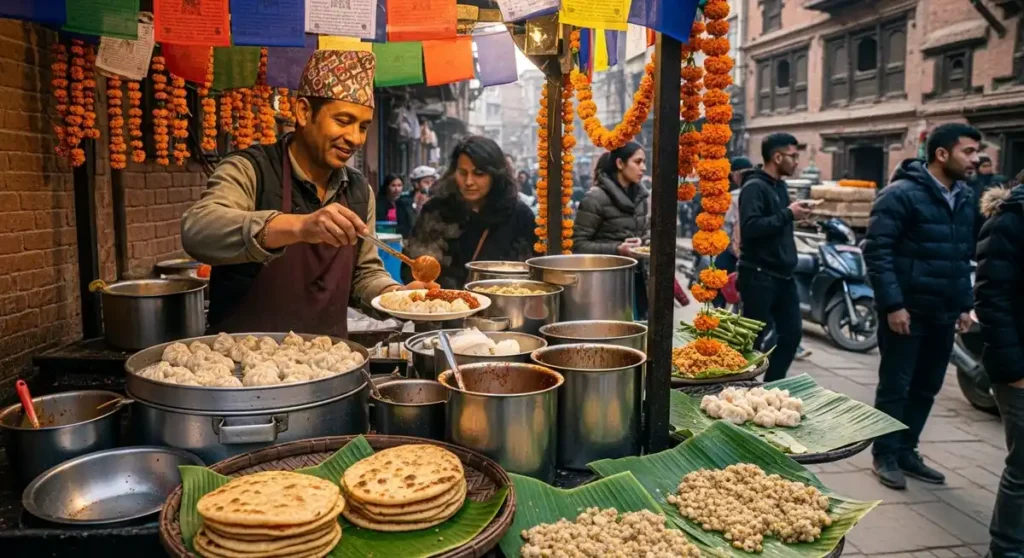
Momo – The Beloved Dumpling
- Soft dumplings filled with meat or vegetables
- Served with spicy chutney
- A favorite dish across all ages
Chatamari – The Nepali Pizza
- Thin rice flour crepe with toppings like eggs or spiced meat
- Traditional dish of the Newar community
- Popular during festivals and gatherings
Sel Roti – Sweet Rice Doughnut
- Ring-shaped bread made from rice flour
- Crispy on the outside, fluffy inside
- Often paired with yogurt or tea
Yomari – A Festive Delight
- Sweet dumpling filled with molasses and sesame seeds
- Special dish of Newar festivals
- Symbol of prosperity and joy
Sekuwa – Grilled Goodness
- Juicy pieces of marinated meat grilled over fire
- Smoky and flavorful taste
- Enjoyed with beaten rice (chiura)
Jhol Momo – Comfort in a Bowl
- Dumplings served in a spicy broth
- Warm, aromatic, and nourishing
- A perfect dish for cool evenings
Pani Puri – Tangy Street Snack
- Crunchy puris filled with spicy, tangy water
- Inspired by India, loved with a Nepali twist
- Popular among youngsters
Street food in Kathmandu is more than just food; it is a celebration of community, tradition, and creativity. Every corner, market, and alley offers a new taste, making the city a true treasure of culinary delights.
21. Live music & nightlife in Thamel
Walking through Thamel at night, you can feel the rhythm of the streets. The area transforms into a vibrant scene with lounges, cocktail bars, and neighborhood bars full of good vibes. Many places have happy hour deals and promotions, making it easy to eat, drink, and hang out while enjoying the local culture and friendly atmosphere.
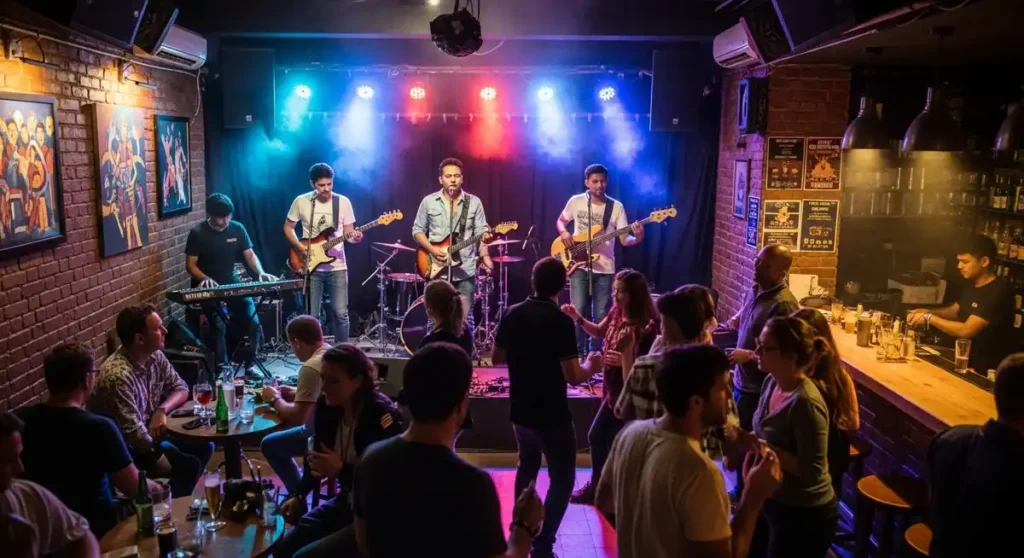
Highlights of Live Music & Bars
- Shisha Lounge and Bar – famous for live music, performances, and hookah
- Reggae Bar – great food, refreshing drinks, and nightly shows
- Jazz Upstairs – the perfect spot for authentic jazz clubs
- Rum Doodle Bar – known for its unique vibes and cozy setting
Nightclubs & Dancing Hotspots
- LOD (Lord of the Drinks) – an award-winning club and a top-rated club in Thamel
- Club Deja Vu – with DJs, themed nights, and a pulsating dance floor
- Senate Club – featuring local bands, good ambiance, and tasty drinks
- Ibyza Lounge & Disco Theque – famous for DJ music and a quality dance floor
During the tourist season from September to December, Thamel becomes a true party hotspot. Both local people and international travelers enjoy the lively neighborhoods, creating an energy that makes it one of the best places for nightlife in Kathmandu, with a touch of charm that rivals Ibiza.
Day Trips & Excursions from Kathmandu
Day trips and excursions from Kathmandu offer a blend of culture, history, and nature. You can visit ancient UNESCO World Heritage Sites like Bhaktapur Durbar Square and Patan, enjoy sunrise views in Nagarkot, take the Chandragiri Cable Car for mountain vistas, explore spiritual sites such as Pashupatinath Temple and Swoyambhunath Stupa, hike in Shivapuri Nagarjun National Park, or experience Namo Buddha’s peaceful hilltop monastery.
Cultural & Historical Day Trips
In Kathmandu Valley, travelers can explore rich heritage through Bhaktapur Durbar Square, an ancient city and UNESCO World Heritage Site with grand palaces, temples, and lively traditions. A Bhaktapur Tour also connects with historic Newari cities, where the local culture thrives.
The Swoyambhunath Stupa (Monkey Temple) is known for its religious significance and wide panoramic views of Kathmandu. Close by, the Pashupatinath Temple, a sacred Hindu temple complex on the banks of the Bagmati River, welcomes visitors to witness deep faith and rituals.
A Kathmandu Heritage Tour brings together several UNESCO World Heritage Sites, including another vibrant Durbar Square, showcasing the historical and cultural charm of the valley.
Scenic & Nature Day Trips
For natural beauty, Nagarkot is famous for its glowing Sunrise View over the Himalayas. The Chandragiri Cable Car ride up Chandragiri Hill rewards visitors with sweeping panoramic views of the mountains and Kathmandu Valley.
In Dhulikhel, travelers enjoy natural scenery and a peaceful escape. The town of Kirtipur highlights temples, cultural sites, and the rhythm of Newari life.
For outdoor adventure, Shivapuri Nagarjun National Park offers hiking, birdwatching, and moments of pure nature, all within reach of the city.
Day Tours from Kathmandu
With Himalayan Social Journey, visitors can join guided day tours in Nepal’s capital. Expert guides bring you to cultural wonders and natural wonders, from seven UNESCO World Heritage Sites to an Everest scenic flight and a relaxing cable car ride to Chandragiri Hill.
Stops at Kathmandu Durbar Square, Pashupatinath Temple, lively markets, and timeless temples are enhanced by warm hospitality and personalized packages. Each tour promises stunning vistas, fascinating stories, and cherished memories.
Kathmandu serves as both the cultural heart and historical heart of Nepal, surrounded by the Himalayas. With cultural landmarks, natural escapes, mountain retreats, and serene settings, the valley offers something for every traveler—be it an adventure seeker, culture enthusiast, or peace seeker.
22. Bhaktapur Durbar Square
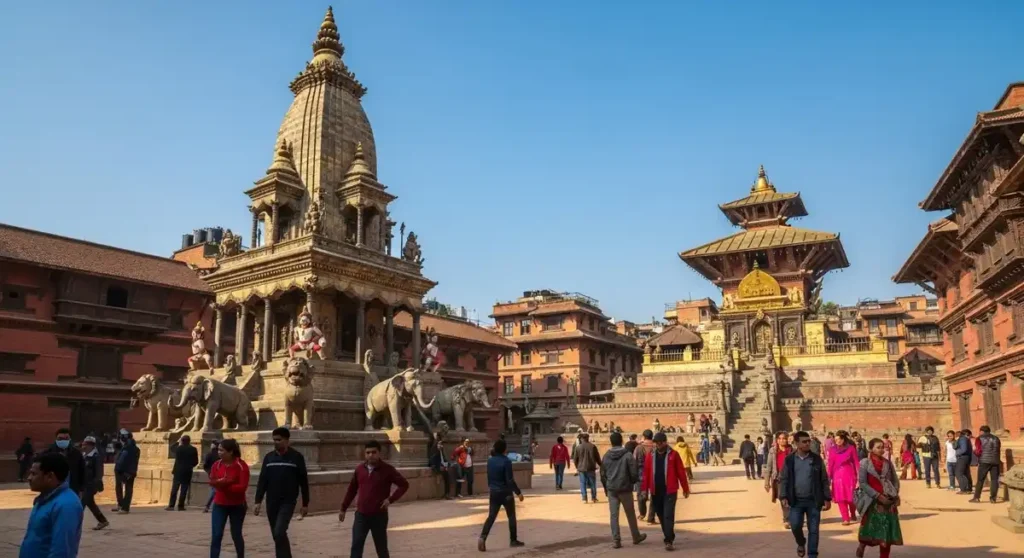
The UNESCO World Heritage Site of Bhaktapur Durbar Square features medieval architecture, detailed wood carvings, and remarkable works by Newar artisans. Highlights include the Nyatapola Temple, the grand Golden Gate, and lively streets filled with historic buildings.
Visitors enjoy courtyards, heritage sites, and unique food at Pottery Square with its authentic Newari cuisine. For photography, the Taumadhi Square offers unmatched beauty, while every step reveals the richness of Nepal’s history.
23. Patan (Lalitpur) Durbar Square
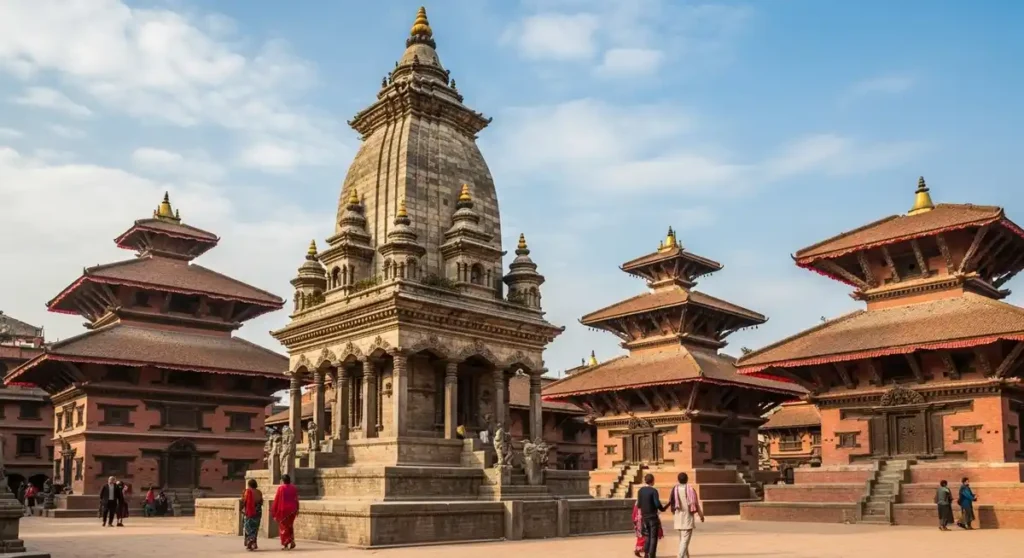
Patan is another UNESCO World Heritage Site celebrated for arts, crafts, and artistic heritage. The Krishna Mandir, built in stone, reflects the mastery of Newar artisans.
At the Patan Museum inside a former royal palace, travelers learn about Nepal’s history and religious art. Courtyards, temples, and traditional homes bring alive old traditions, giving visitors a deep sense of the cultural soul of the Kathmandu Valley.
24. Changu Narayan Temple
The Changu Narayan Temple is the oldest in Nepal and a UNESCO World Heritage Site. Known for both historical significance and spiritual significance, it stands on a hill near Kathmandu.
Its fine architecture, detailed carvings, and records dating to 464 AD show the depth of history. Inside are figures of Hindu gods, mythological animals, and intricate stone carvings and wood carvings.
The surrounding village offers small museums, cozy restaurants, and a good day hike with sweeping valley views of the Kathmandu Valley.
25. Namo Buddha
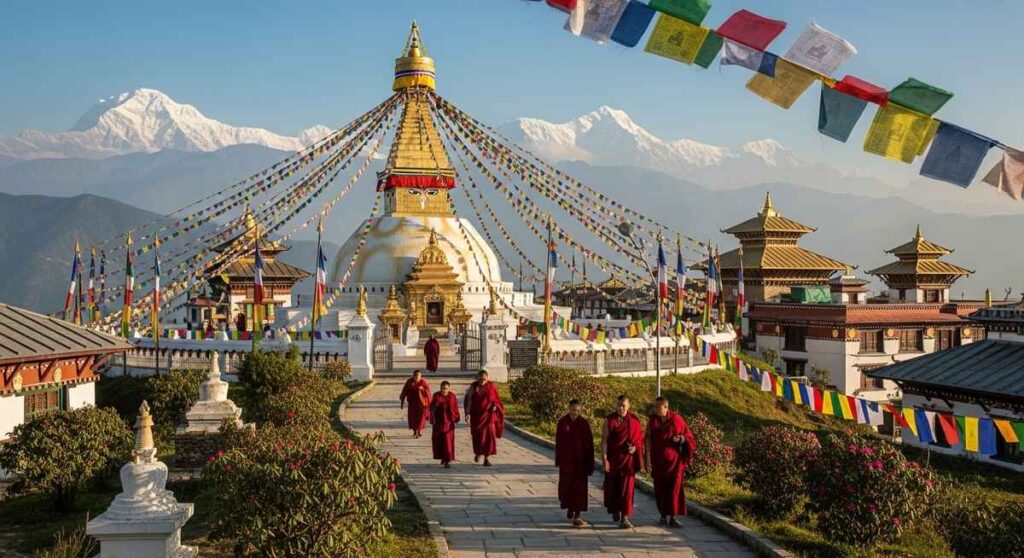
Namo Buddha is a revered Buddhist pilgrimage site near Kathmandu, set on a quiet hilltop. This sacred site is tied to the legend of Prince Mahasattva and Lord Buddha, making it a place of spiritual significance.
The Namo Buddha Monastery, an architectural marvel, hosts peaceful prayer ceremonies filled with calming energy. Visitors often describe finding inner peace, spiritual enrichment, and even glimpses of enlightenment.
The trails here lead past valleys, Himalayan peaks, green forests, and traditional villages with authentic Nepali lifestyles. Many pilgrims and travelers enjoy this mix of natural beauty and cultural exploration.
Nearby, the Thrangu Tashi Yangtse Monastery offers breathtaking mountain views and a deep sense of spiritual tranquility, making it a memorable retreat.
Suggested Kathmandu Itineraries
24 hours in Kathmandu
24 hours in Kathmandu can be full of joy and culture. From a glowing sunrise to exploring UNESCO sites, sacred temples, colorful streets, and ending with a warm Newari meal, one perfect day in Nepal’s capital offers history, beauty, and unforgettable experiences.
A single day in Kathmandu feels like a journey through time and spirit. The capital of Nepal is where mountains, jungles, and tradition meet. With its international airport, many visitors begin their trip here. Even in a short day, you can enjoy the highlights, rich culture, and the charm of the Kathmandu Valley with a smartly planned itinerary.
Perfect 24 Hours Itinerary in Timings
- 9:00 AM – 12:00 PM → Explore Kathmandu Durbar Square, a UNESCO World Heritage site with historic palaces, temples, shrines, and the Kumari Ghar, home of the living goddess.
- 12:00 PM – 2:00 PM → Visit Swayambhunath (Monkey Temple), a Buddhist complex on a hilltop, with a grand stupa, sweeping views of the Kathmandu Valley, and playful monkeys.
- 2:00 PM – 5:00 PM → Experience the sacred Pashupatinath Temple on the Bagmati River, one of the most important Hindu temples in the country, and witness spiritual rituals.
- 5:00 PM – 7:00 PM → Head to the Boudhanath Stupa, the largest Buddhist stupa in Nepal, and feel the spiritual atmosphere with devoted worshippers at this vibrant hub.
- 7:00 PM onwards → Conclude in Thamel, the lively district filled with glowing streets, handicraft shops, and tasty dining options. End your day with a flavorful Newari meal for the best Kathmandu experience.
2–3 day itinerary
A 2–3 day itinerary in Kathmandu covers its best cultural and scenic highlights. Day 1 focuses on Kathmandu’s Durbar Square, Thamel, and Swayambhunath. Day 2 takes you to Patan Durbar Square, Pashupatinath, and Boudhanath. Day 3 can be spent exploring Bhaktapur or enjoying Himalayan views from Nagarkot.
Day 1: Kathmandu’s Cultural Heart
Begin your journey at Kathmandu Durbar Square, a UNESCO World Heritage Site with temples, palaces, and a royal complex. Continue to the Thamel district in the afternoon for local culture, shops, and eateries. End the day with a short hike up to Swayambhunath (Monkey Temple). From the hilltop, you’ll enjoy panoramic city views and a glowing sunset.
Day 2: Patan & Pashupatinath
Start the morning at Patan Durbar Square, known for its Newari architecture, the former palace of the Malla kings, and the Patan Museum. Don’t miss the Golden Temple, tucked around the corner. In the afternoon, head to the sacred Pashupatinath Temple on the Bagmati River, an important Hindu site.
Later, explore the Boudhanath Stupa, one of the largest Buddhist stupas in Nepal, where the vibrant atmosphere grows as devotees circle the site in the evening.
Day 3: Bhaktapur or Nagarkot
Choose between two memorable experiences. For culture, visit Bhaktapur Durbar Square, a preserved medieval city with intricate architecture, pottery drying in the squares, and the towering multi-tiered Nayatapola Temple.
For scenery, take a trip to Nagarkot. From this vantage point, the breathtaking Himalayas come into view, and on clear mornings even Mount Everest is visible. A sunrise or sunset here shows the natural beauty of the Valley.
Conclusion
Kathmandu is more than a destination—it’s an experience. With its temples, food, music, and mountain views, the city captures your heart and keeps calling you back. Every step here is a memory waiting to happen.
FAQs About Visiting Kathmandu
What is the famous thing of Kathmandu?
Kathmandu is famous for its temples, stupas, and royal squares. Pashupatinath, Boudhanath, and Swayambhunath are world-known spiritual sites. The city is also known for its busy bazaars, Thamel streets, and rich Newari culture.
What to do in Kathmandu for 7 days?
In 7 days, you can explore Durbar Squares, Pashupatinath, Swayambhunath, and Boudhanath. Visit Patan, Bhaktapur, and Changu Narayan for history. Take day trips to Nagarkot, Dhulikhel, or Namo Buddha. Try local food, shop in Thamel, and enjoy live music at night.
How many days in Kathmandu is enough?
Two to three days are enough to see the main highlights. You can cover Durbar Squares, key temples, and stupas in this time. With more days, you can enjoy day trips and relax in the valley.
What to do for a day in Kathmandu?
In one day, you can visit Kathmandu Durbar Square in the morning. Go to Swayambhunath for city views, then Pashupatinath for its spiritual feel. End at Boudhanath for evening prayers and dinner in Thamel.
Is Kathmandu safe?
Yes, Kathmandu is safe for travelers. People are warm and welcoming, and tourist areas are lively. Basic care like watching your things and using safe transport makes the visit smooth.
What should I avoid in Kathmandu?
Avoid drinking tap water and eating food from unhygienic stalls. Skip overcrowded streets late at night. Also, avoid touching sacred objects without asking and dress modestly at temples.
What is famous to buy in Kathmandu?
Kathmandu is famous for pashmina shawls, singing bowls, and Thangka paintings. You can also buy khukuri knives, handmade jewelry, and Lokta paper crafts. Trekking gear in Thamel is also popular with travelers.
Which month is best to visit Kathmandu?
Autumn (September to November) is the best time to visit. The weather is clear, festivals are lively, and mountain views are stunning. Spring (March to May) is also great with blooming flowers.
How much money do I need per day in Nepal?
You may need $25–50 per day for food, transport, and sightseeing. Budget travelers can spend less, while luxury travelers may spend more. Kathmandu offers choices for all types of budgets.
How far is Mount Everest from Kathmandu?
Mount Everest is about 160 km northeast of Kathmandu. You can take a short flight to Lukla to start the trek. Helicopter tours also give a quick view of the peak from the city.
Is Kathmandu expensive for tourists?
No, Kathmandu is affordable compared to many cities. Street food, transport, and stays are budget-friendly. There are also luxury hotels and fine dining for those who want comfort.
Can I trek without leaving Kathmandu Valley?
Yes, you can trek inside the valley. Shivapuri, Nagarjun, and Chisapani offer great short treks. These trails have nature, villages, and views of the Himalayas without leaving Kathmandu.
Disclaimer
This article is for informational purposes only. Travel details, recommendations, and tips are based on research and experience. Please verify current conditions before planning your trip. Traveldrizzle.com is not responsible for changes in services, prices, or local regulations.
